Ozone Hole is one of the BIGGEST on record: Gap over Antarctica is now three times the size of Brazil – and it could get even larger
>
Satellite data has revealed that the ozone hole over Antarctica is now one of the largest on record after expanding to three times the size of Brazil.
Worse still, it could become larger than the 10.3 million square miles (26 million square kilometers) measured on September 16, because depletion typically does not peak until mid-October.
Scientists aren’t sure why the ozone hole is so large this year, but some researchers speculate it could be linked to an underwater volcanic eruption in Tonga in January 2022.
Its explosion was equivalent to the most powerful American nuclear test ever and the largest natural explosion in more than a century.
The size of the ozone hole fluctuates regularly.
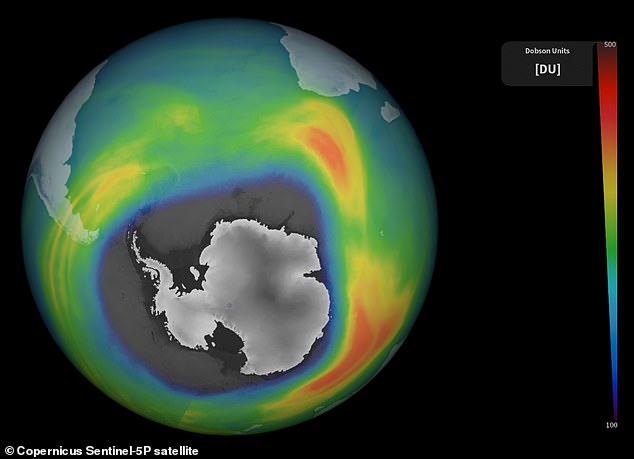
The gap: Satellite data revealed that the ozone hole over Antarctica is now one of the largest on record after expanding to three times the size of Brazil.
Every August, at the beginning of Antarctica’s spring, growth begins and peaks around October, before tapering off slightly and eventually closing down again.
This happens because Antarctica enters summer and temperatures in the stratosphere begin to rise.
When this happens, the mechanism that depletes the ozone and creates the hole slows down and eventually stops, preventing the hole from growing again.
The hole has closed later than usual in the past three years, partly due to Australia’s Black Summer bushfires in 2019-2020, which released large amounts of ozone-damaging smoke.
It also opened several weeks early this year, at the beginning of August, and it’s not clear when it will close for sure.
Ozone depletion over the frozen continent was first observed in 1985, and over the past 35 years, various measures have been taken to try to shrink the hole.
Experts are confident that the Montreal Protocol introduced in 1987 has helped the hole recover, but measurements made this year from the European Copernicus Sentinel-5P satellite represent a blow.
“The Operational Ozone Monitoring and Forecasting Service shows that the 2023 ozone hole got off to an early start and has grown rapidly since mid-August,” said Antje Innes, senior scientist at the Copernicus Atmosphere Monitoring Service (CAMS).
“It reached a size of more than 26 million square kilometers on September 16, making it one of the largest ozone holes on record.”
She explained that the eruption of the underwater volcano of Tonga may have been the cause.
Dr. Innes said: “The eruption of the Hunga Tonga volcano in January 2022 pumped a lot of water vapor into the stratosphere, which did not reach the Antarctic regions until after the end of the ozone hole in 2022.”
“Water vapor can increase the formation of polar stratospheric clouds, where chlorofluorocarbons (CFCs) can interact and accelerate ozone depletion.
“The presence of water vapor may also contribute to the cooling of the Antarctic stratosphere, further enhancing the formation of these polar stratospheric masses and leading to a stronger polar vortex.”
Despite this theory, scientists warn that the exact impact of the eruption on the crater is still the subject of ongoing research.
However, there is precedent for this.
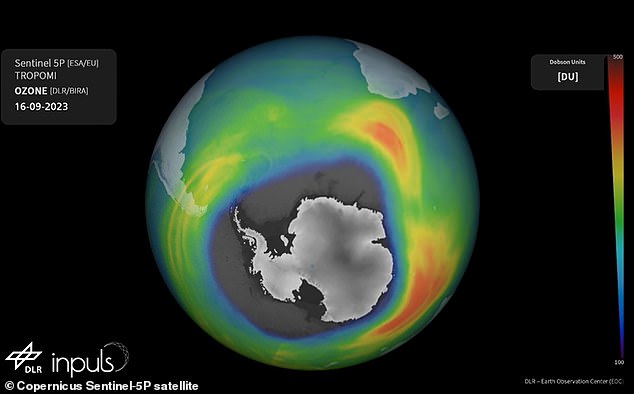
Theory: Scientists aren’t sure why the ozone hole is so large this year, but some experts speculate it could be linked to an underwater volcanic eruption in Tonga in January 2022.
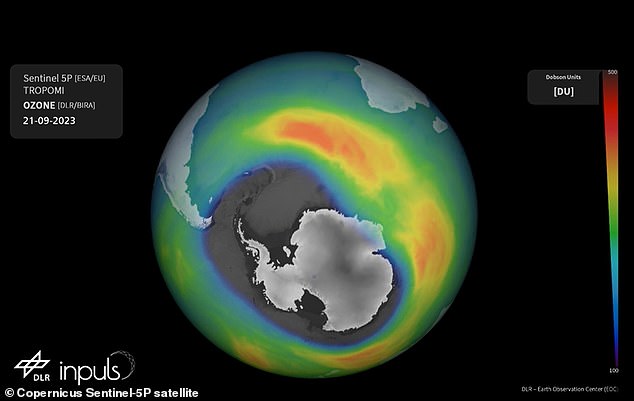
The size of the ozone hole fluctuates regularly. Every August, at the beginning of the Antarctic spring, it begins to grow and reaches its peak around October, before subsiding slightly and eventually closing down again.
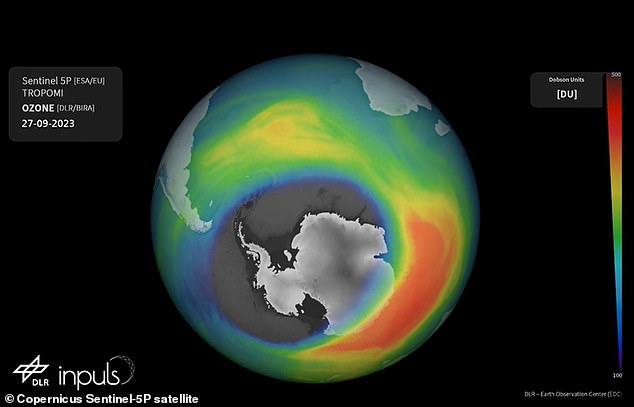
The challenge: Ozone depletion over the frozen continent was first observed in 1985, and over the past 35 years, various measures have been taken to try to shrink the hole.
In 1991, the eruption of Mount Pinatubo released large amounts of sulfur dioxide, which was later shown to have exacerbated ozone depletion.
Ozone depletion depends on temperatures so cold that only at -78 °C (-108 °F) can a certain type of cloud form, called polar stratospheric clouds.
These frozen clouds contain ice crystals that convert inert chemicals into reactive compounds, destroying the ozone layer.
The chemicals in question are substances containing chlorine and bromine that become chemically active in the frozen vortex hovering over Antarctica.
They were produced in large numbers at the end of the 20th century when halocarbons such as CFCs and hydrochlorofluorocarbons (HCFCs) were regularly used as refrigerants in refrigerators and aerosol cans.
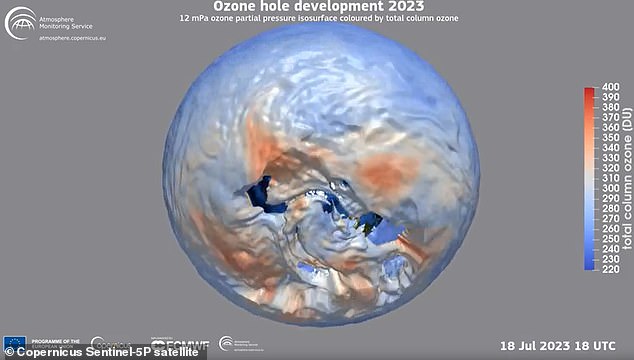
Ozone depletion depends on extremely cold temperatures, as it is only at -78°C that a certain type of cloud can form, called polar stratospheric clouds. This 3D graphic shows how the ozone hole over Antarctica will change during 2023, with a snapshot from July
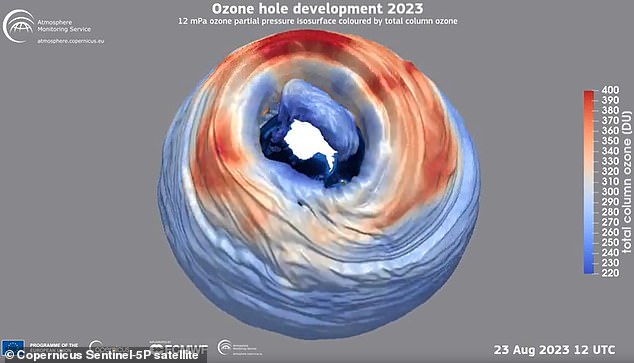
Comparison These images above capture what ozone looked like in August of this year
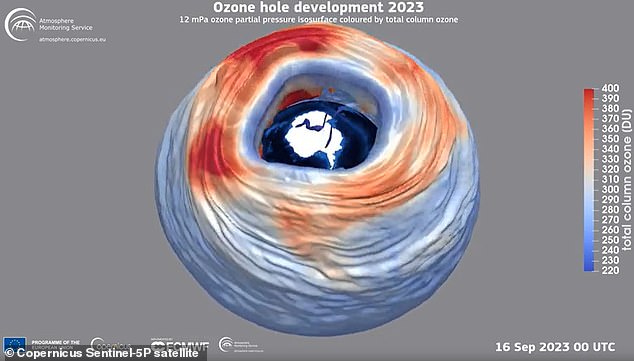
Near its peak: This image captures the ozone layer when its size reached 26 million square kilometers
In response, the Montreal Protocol was created to protect the ozone layer by phasing out the production and consumption of these harmful substances.
ESA’s mission director for Copernicus Sentinel-5P, Klaus Zenner, said this led to the recovery of the ozone layer, adding: “Scientists currently predict that the global ozone layer will reach its natural state again by around 2050.”
Ozone is a compound made up of three oxygen atoms and is naturally present in trace amounts high in the atmosphere.
It is toxic to humans when ingested, but at its towering ten miles above the Earth’s surface, it actually protects us from harmful ultraviolet rays from the sun.
The Copernicus Sentinel-5P satellite was launched in October 2017 and is the first of Europe’s Copernicus satellites dedicated to monitoring the Earth’s atmosphere.
It contains a state-of-the-art instrument capable of detecting atmospheric gases to image air pollutants more precisely and at a higher spatial resolution than ever before from space.
(Tags for translation)dailymail
